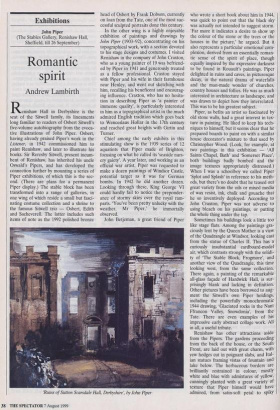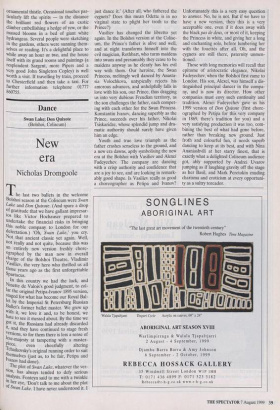Exhibitions
John Piper (The Stables Gallery, Renishaw Hall, Sheffield, till 26 September)
Romantic spirit
Andrew Lambirth
Renishaw Hall in Derbyshire is the seat of the Sitwell family, its lineaments long familiar to readers of Osbert Sitwell's five-volume autobiography from the evoca- tive illustrations of John Piper. Osbert, having already praised Piper's work in the Listener, in 1942 commissioned him to paint Renishaw, and later to illustrate his books. Sir Reresby Sitwell, present incum- bent of Renishaw, has inherited his uncle Oswald's Pipers, and has developed the connection further by mounting a series of Piper exhibitions, of which this is the sec- ond. (There are plans for a permanent Piper display.) The stable block has been transformed into a range of galleries, in one wing of which reside a small but fasci- nating costume collection and a shrine to the famous Sitwell trio — Osbert, Edith and Sacheverell. The latter includes such items of note as the 1992 polished bronze head of Osbert by Frank Dobson, currently on loan from the Tate, one of the most suc- cessful sculpted portraits done this century.
In the other wing is a highly enjoyable exhibition of paintings and drawings by John Piper (1903-92), concentrating on his topographical work, with a section devoted to his stage designs and costumes. I visited Renishaw in the company of John Craxton, who as a young painter of 19 was befriend- ed by Piper in 1941 and generously treated as a fellow professional. Craxton stayed with Piper and his wife in their farmhouse near Henley, and went out sketching with him, recalling his beneficent and encourag- ing influence. Craxton, who has no hesita- tion in describing Piper as 'a painter of immense quality', is particularly interested in him as a topographical artist in the much admired English tradition which goes back to Wenceslaus Hollar in the 17th century and reached great heights with Girtin and Turner.
Chief among the early exhibits in this stimulating show is the 1939 series of 12 aquatints that Piper made of Brighton, focusing on what he called its 'seaside nurs- ery gaiety'. A year later, and working as an official war artist, Piper was requested to make a dozen paintings of Windsor Castle, potential target as it was for German bombs. In 1942 he did another dozen. Looking through these, King George VI could hardly fail to notice the preponder- ance of stormy skies over the royal ram- parts. 'You've been pretty unlucky with the weather, Mr Piper,' he immortally observed.
John Betjeman, a great friend of Piper Ruins of Sutton Scarsdale Hag Derbyshire', by John Piper who wrote a short book about him in 1944, was quick to point out that the black sky was actually not intended to suggest storm. 'Far more it indicates a desire to show up the colour of the stone or the trees or the houses in the picture,' he argued. But it also represents a particular emotional com- plexion, derived from an essentially roman- tic sense of the spirit of place, though equally inspired by the expressive darkness to be found in Rouault's paintings. Piper delighted in ruins and caves, in picturesque decay, in the natural drama of waterfalls and the man-made wonder of churches, country houses and follies. He was as much interested in architecture as landscape, and was drawn to depict how they interrelated. This was to be his greatest subject.
Piper, as befits an artist so fascinated by old stone walls, had a great interest in tex- ture in painting. He liked to keep his tech- niques to himself, but it seems clear that he prepared boards to paint on with a similar house decorator's mixture to that used by Christopher Wood. (Look, for example, at two paintings in this exhibition — 'All Saints Chapel, Bath' and 'Somerset Place', both buildings badly bombed and the image textures appropriately distressed.) When I was a schoolboy we called Piper `Splot and Splash' in reference to his meth- ods, but there's no doubt that he teased out great variety from the oils or mixed media of wax resist, ink, chalk and gouache that he so inventively deployed. According to John Craxton, Piper was not adverse to using bleach on his paintings, or putting the whole thing under the tap.
Sometimes his buildings look a little too like stage flats. Among the paintings gra- ciously lent by the Queen Mother is a view of the Quadrangle at Windsor, looking east from the statue of Charles II. This has a curiously insubstantial cardboard-model air, which contrasts strongly with the solidi- ty of 'The Stable Block, Frogmore', and another view of the Quadrangle, this time looking west, from the same collection. There again, a painting of the remarkable all-glass facade of Hardwick Hall, is sur- prisingly blank and lacking in definition. Other pictures have been borrowed to aug- ment the Sitwell's own Piper holdings, including the powerfully monochromatic 1944 drawing, 'Glaciated rocks in the Nant Ffrancon Valley, Snowdonia', from the Tate. There are even examples of his impressive early abstract collage work. All in all, a useful tribute.
Renishaw has other attractions aside from the Pipers. The gardens proceeding from the back of the house, or the South Front, are laid out with great charm, with yew hedges cut in poignant slabs, and Ital- ian statues framing vistas of fountain and lake below. The herbaceous borders are brilliantly restrained in colour, mostly white and blue with admixtures of yellow, cunningly planted with a great variety of texture that Piper himself would have admired, from satin-soft petal to spilry ornamental thistle. Occasional touches par- ticularly lift the spirits — in the distance the brilliant red flowers of an exotic Climber embellishing a hedge of yew, or the massed blooms in a bed of giant white hydrangeas. Several people were sketching in the gardens, others were sunning them- selves or reading. It's a delightful place to while away an hour or two, and the house itself with its grand rooms and paintings (a resplendent Sargent, more Pipers and a very good John Singleton Copley) is well worth a visit. If travelling by train, proceed to Chesterfield and then take a taxi. For further information telephone 01777 860755.



























































 Previous page
Previous page